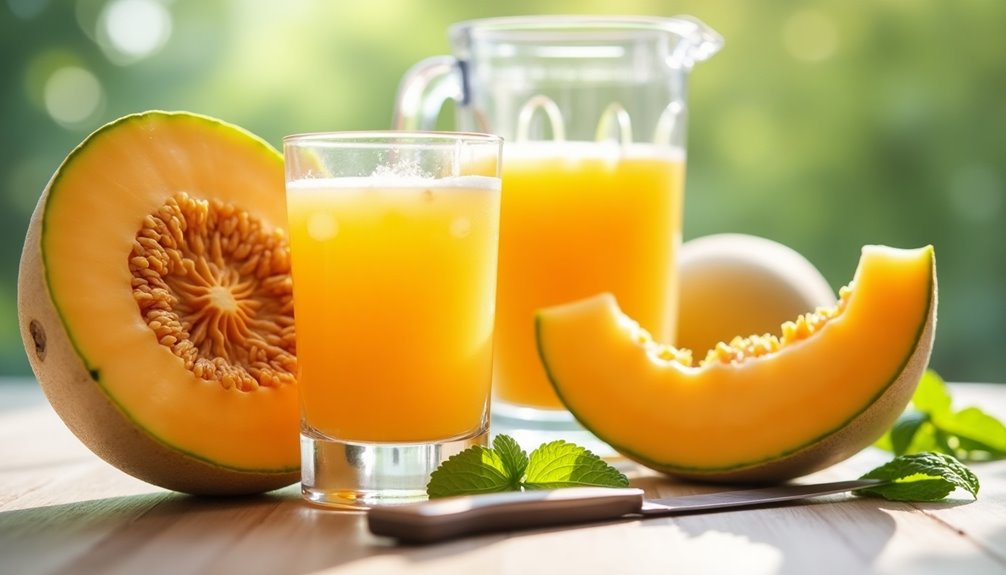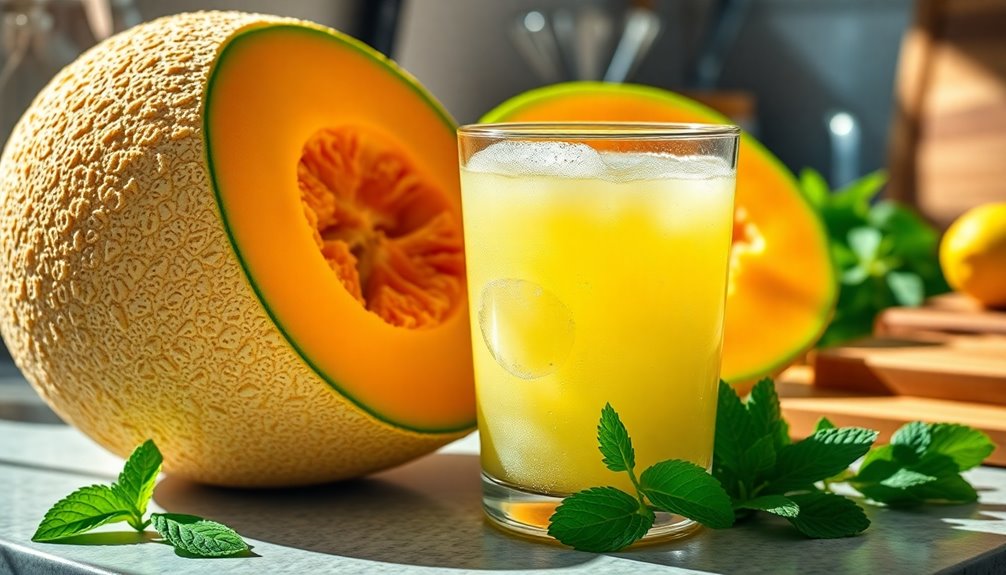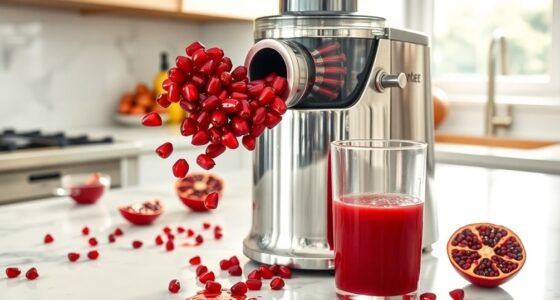To make cantaloupe juice, start by picking a ripe cantaloupe with a light yellow rind and a sweet aroma. Cut it in half, scoop out the seeds, and slice the flesh into chunks. Blend those chunks with a splash of cold water and a drizzle of honey or agave syrup until smooth. Strain the mixture to remove pulp, then serve over ice, garnished with mint. There's even more to explore about perfecting this delicious drink!
Key Takeaways
- Select a ripe cantaloupe with a light yellow rind, heavy feel, slight give, and sweet aroma at the stem end.
- Cut the cantaloupe in half, scoop out the seeds, and slice the flesh into uniform chunks.
- Blend cantaloupe chunks with a splash of cold water and optional sweeteners like honey or lime juice until smooth.
- Strain the blended mixture through a fine mesh strainer to separate juice from pulp for a smooth texture.
- Serve fresh cantaloupe juice over ice, garnished with mint, and store any leftovers in an airtight container for up to three days.

If you're craving a refreshing drink on a hot day, making cantaloupe juice is a delicious and easy option. This homemade fresh juice not only tastes amazing but also provides a burst of hydration.
To start your juice-making adventure, you'll need to choose a ripe cantaloupe. Look for one with a light yellow rind, which indicates ripeness. It should feel heavy for its size and have a slight give when you press it gently. Once you've selected the perfect fruit, cut it in half and scoop out the seeds.
Next, slice the cantaloupe flesh into chunks. You want enough pieces to make blending simpler. Toss these chunks into your blender, and for a delightful twist, add a splash of cold water and a drizzle of honey or agave syrup to sweeten the mixture. If you're feeling adventurous, consider adding a squeeze of lime juice or a hint of fresh ginger, which can enhance the flavor profile, making your cantaloupe juice even more refreshing.
Blend the mixture until it’s smooth and well combined. The goal here is to achieve a silky consistency that’ll make your juice enjoyable. Once you’ve reached that desired smoothness, it’s time to pour the mixture into a clean container. This is the perfect moment to experiment with flavors if you wish, adding fruits or herbs to enhance the taste. For those interested in a unique twist on traditional juices, researching how to create cbd e juice can open up new avenues for flavor and wellness.
Once you've blended it, it's time to strain the pulp. Pour the mixture through a fine mesh strainer or cheesecloth into a bowl or pitcher. This step is essential for separating the juice from the pulp, giving you that smooth, drinkable texture. You might want to use a spatula or spoon to help push the juice through the strainer, ensuring you get every drop of delicious goodness.
Once you've strained out the pulp, you can serve the fresh cantaloupe juice immediately over ice. For an extra touch of freshness, garnish your drink with some fresh mint leaves. This adds a vibrant color and aromatic flair that elevates the experience. Enjoy your homemade fresh cantaloupe juice right away for the best flavor. The chilled juice is sure to refresh you on a warm day.
If you happen to have any leftover juice, don't worry! You can store it in an airtight container in the refrigerator for up to three days. Just remember to give it a good stir before serving, as it may separate over time.
And don't let that pulp go to waste! You can repurpose it in smoothies or add it to baking mixes for extra flavor and nutrients.
In just a few simple steps, you've created a delicious, refreshing drink that's perfect for quenching your thirst. So, next time you have a ripe cantaloupe on hand, remember this easy recipe for a delightful treat! Enjoy every sip!
Frequently Asked Questions
Is Juicing Cantaloupe Good for You?
Juicing cantaloupe is great for you!
It's packed with hydration, boasting a high water content that keeps you refreshed, especially on hot days.
You'll get a significant dose of vitamin C, supporting your immune system and skin health.
Plus, the potassium in it helps regulate blood pressure and promotes heart health.
With its low-calorie count, it satisfies your sweet cravings without the guilt, aiding in digestion and weight management.
Enjoy the benefits!
How Do You Make a Cantaloupe Drink?
Creating a cool, crisp cantaloupe concoction is simple and satisfying.
Start by slicing the sweet, succulent fruit into chunks. Blend those juicy pieces with chilled water until they're perfectly smooth.
If you like a little zing, toss in some lime juice for a flavor boost. Strain the mixture to separate the juice from the pulp, then serve it over ice.
Garnish with mint for a refreshing finish that's sure to impress!
How Do You Make Melon Juice?
To make melon juice, start by picking a ripe melon with a firm and fragrant exterior.
Cut it in half, scoop out the seeds, and chop the flesh into chunks.
Blend the chunks with some cold water and, if you like, add a sweetener like honey.
For a smoother juice, strain the mixture through a fine mesh strainer.
Chill it in the fridge, serve over ice, and enjoy a refreshing drink!
How to Cut Cantaloupe for Juice?
To cut cantaloupe for juice, start by selecting a ripe fruit that feels slightly soft when pressed.
Slice it in half from stem to stem with a sharp knife.
Scoop out the seeds using a spoon, discarding them.
Then, cut the cantaloupe flesh into manageable chunks or wedges.
For easier blending, you might want to shred the flesh into long strands using a coconut grater or a fork.
Now, you're ready to juice!
Conclusion
Now that you've learned how to make delicious cantaloupe juice, you can enjoy a refreshing drink that's perfect for any occasion. It's funny how something as simple as blending fruit can transform your day. One moment you're feeling sluggish, and the next, a glass of fresh juice rejuvenates you, sparking inspiration for new recipes or summer gatherings. So grab that ripe cantaloupe, and let the coincidences of flavor and creativity flow into your kitchen!
Cindy thoroughly researches juicing trends, techniques, and recipes to provide readers with practical advice and inspiration. Her writing style is accessible, engaging, and designed to make complex concepts easy to understand. Cindy’s dedication to promoting the advantages of juicing shines through her work, empowering readers to make positive changes in their lives through the simple act of juicing.











